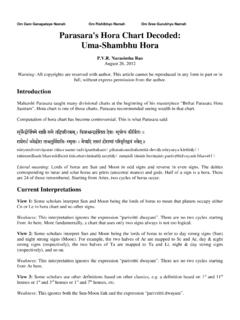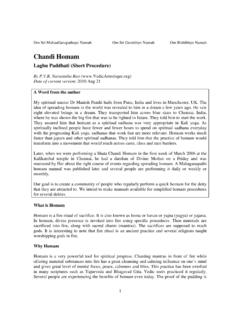Transcription of A Children’s guide to perform Lord Ganesha Pooja
1 A children s guideto perform lord Ganesha PoojaPrepared byHindu Swayamsevak Sangh and Samskrita Bharati, USAShri Madhavrao Sadahivrao Golwalkar Guruji (1906 - 1973)For more information about Guruji more informaton about HSS booklet is especially prepared for the Hindu children of America. It was first printed in year 2006, on the occasion of Shri Guruji s birth centenary. After getting a tremendous response from saamuhik Ganesha Pooja utsav participants, swayamsevaks, and sevikas, we are happy to provide you with a 2nd edition of this booklet.
2 Some changes are made based on the feedback received. Publisher:Hindu Swayamsevak Sangh121 Hawthorne CtRockaway, NJ 07866 ParentsWe are happy to publish this booklet on the Pooja -vidhi of lord Ganesha . Our only intentions are to provide Hindu children of America with the primary information of lord Ganesha and let them know the simple way of performing Pooja . Although the contents of this booklet are verified from the scholars, there may be inadequacies or differences from the regional Pooja -vidhi.
3 In this regards, your feedback will surely be helpful to improve the contents when it is printed next time. In case you want to participate and contribute to this and other such several activities taken up by HSS, please feel free to contact us at GaneshaHindus accept the existence of several gods, goddesses, and dities in the forms of animals and planets. Hindus also believe that all these gods/goddesses are not separate entities but different forms (modes) of the same supreme reality (Supreme-God or Paramaatman).
4 Supreme God manifests himself in different forms or aspects for specific purposes. Hindus have free will to choose any form of the supreme God (Ishta Devata) to worship and pray. Whichever form they may choose to pray or worship, ultimately it leads to the supreme Ganesha is also one of the many forms of the God. He is also the first child of lord Shiva and Goddess Parvati. He is known by various names such as Vinayaka (knowledgeable), Vighneshwara (remover of obstacles), Gajanana (elephant faced) or Ganapati (a leader).
5 lord Ganesha has all leadership qualities. HE is a very unique form of the Supreme God. HIS unique form also carries symbolic meaning. Scholars interpret it in various ways. Following is the most commonly believed symbolic meaning. Symbolic Meaning: Ganesha has elephant s head, which is big. It symbolizes sharp intelligence and big thinking. An elephant s life is full of radiance, which comes from dignity and self-esteem. Also the elephant shares his food by scattering some around himself.
6 It indicates the sense of has large ears, but small mouth. It indicates that one should talk less and listen more, but retain only the positive and constructive things. Large ears are also a symbol of acute and superior hearing. Ganesha s small eyes indicate sharp vision and concentration. Small eyes are also a symbol of is the symbol of high strength, efficiency and adaptability. It can move the biggest obstacles and yet infinitely gentle in handling delicate objects. Ganesha has one full and other half tusk.
7 The partial tusk symbolizes intelligence and the full tusk symbolizes faith. Both are needed to progress in life. However, the intelligence often falls short in providing answers to life s burning questions. When it falls short, faith in God and ourselves can lead us in life successfully. Full tusk also symbolizes that one should retain good and throw away bad s four hands have four things - Ankush (Elephant driver s iron rod or axe) It indicates us to cut off all bonds of attachment and restrain desires and passions.
8 Paash (cord or rope) symbol of restrain and punishment. Modak is dry and hard from outside and sweet from inside and nourishing. This represents that hard work (saadhana) brings joy, satisfaction and nourishment to our souls. Aashirwaad means that 12 Ganaesha blesses and protects us on our spiritual path to the Supreme. Ganesha has large stomach. HE peacefully digests all good and bad things without loosing control. Ganesha s small legs indicate that one should not move hastily. One must not rush into anything.
9 Each step must be slow, deliberate and well thought of Ganesha symbolizes desire. Desire, if not in control, can causes havoc. Ganesha rides on the mouse. One should ride the desire and keep it under control and do not allow it to take you for a , meaning grass, is placed on the head of Ganesh. The grass is something that we constantly walk on or trample on, paying little heed to it, while in fact it contributes so much to our survival by giving us oxygen. But we give importance to durva by placing them on his head.
10 This tells us no matter how much you are looked down upon or insignificant to others or not given the importance you deserve, you are important to Him. Red flower indicates red color. Red color stands for total change or revolution. lord Ganesha possesses all leadership qualities. The best Pooja offered to lord Ganesha is to inculcate those qualities in us. Ganesha Chaturthi: Chaturthi means a 4th day of the month according to the Hindu calendar. It is the day of lord Ganesha . Especially, 4th day of the month Bhaadrapada (August-September) is celebrated as a Ganesha Festival.







